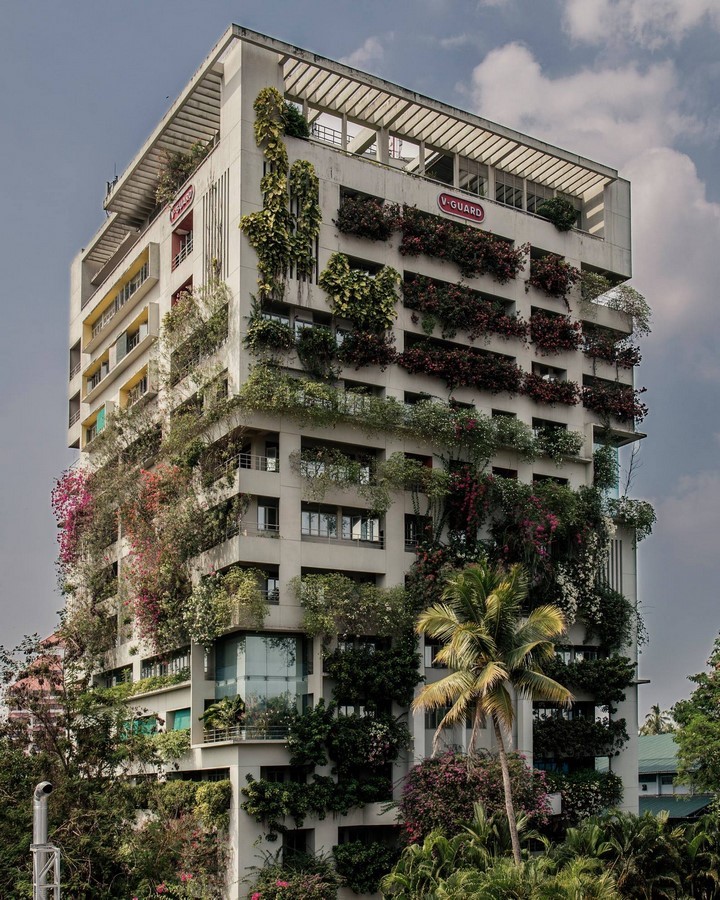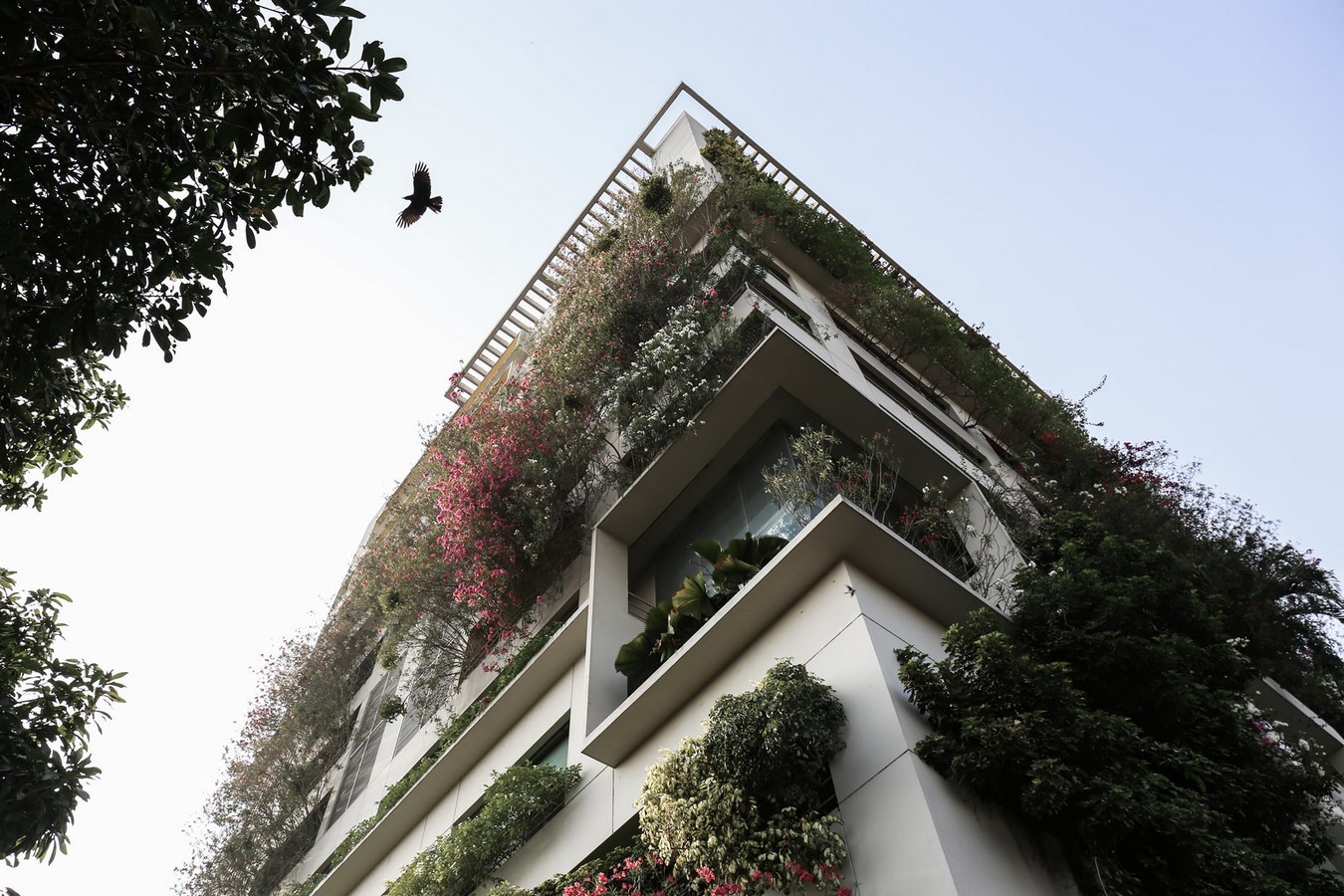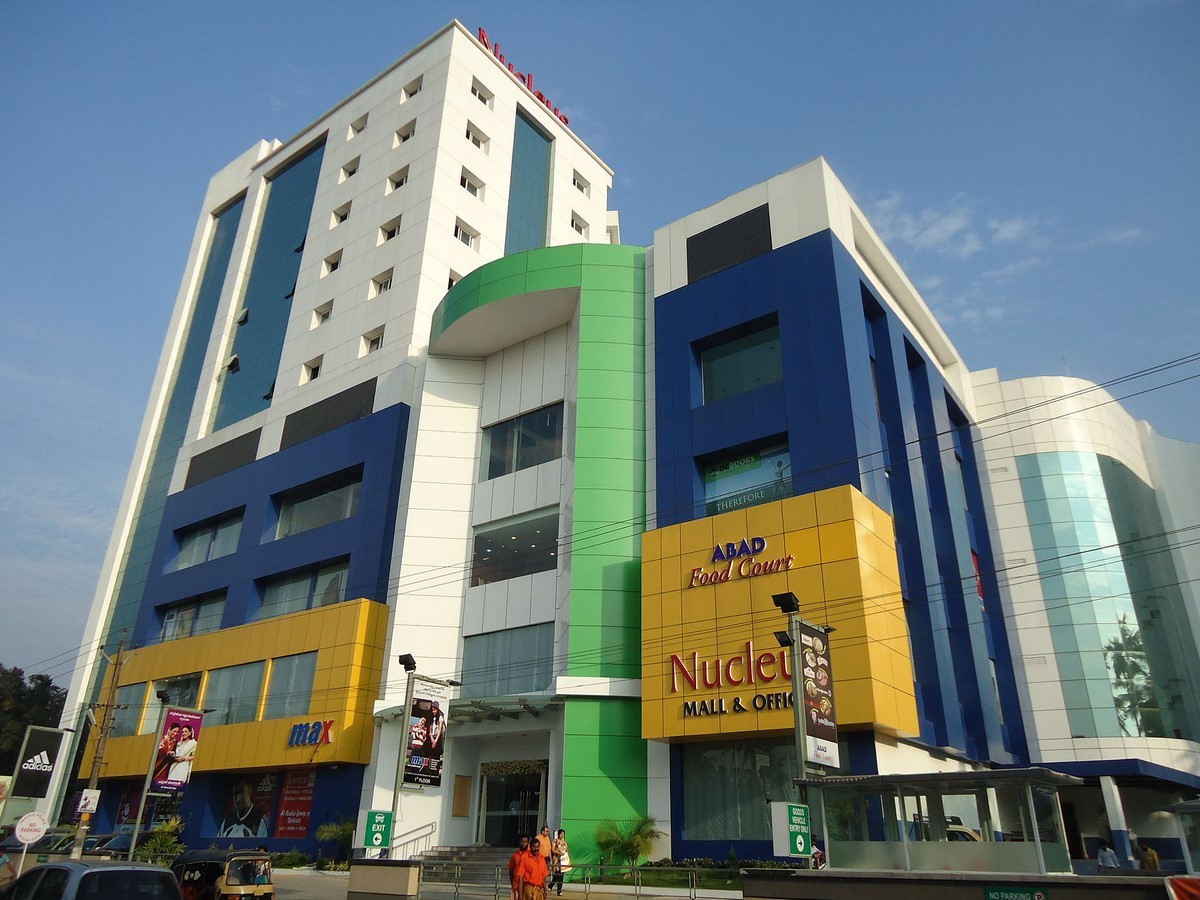Introduction
Green architecture, also known as ‘sustainable architecture’ or ‘green building,’ is the theory, science, and style of buildings designed and constructed by environmentally friendly principles. Green architecture strives to reduce the number of resources consumed in the building’s construction, use, and operation and curtail the harm done to the environment through the emission, pollution, and waste of its components. In Kochi, situated in the southern state of Kerala, India, the sustainability concept is generally booming, and architects are trying to create more self-sustaining structures. The common concern these days is about how buildings are maintained today. Understanding how specific factors like climatic conditions, site constraints, energy consumption, carbon emission, building layout, occupants’ comfort, etc., get impacted due to some design amendments made throughout the project is essential since that could also mean that it could have affected the sustainability factor.
- V-Guard Corporate Office, Vennala, Kochi

This magnificent 12-story building is designed to create an environment-friendly building in Kochi by employing green building principles. Workstations are provided for more than 400 employees in the structure; there is a cafeteria that can accommodate 200 people, four conference halls of varying capacities from 20 to 200 people, and a rooftop meeting place that can accommodate about 500 people. In addition, the building has a roof garden, fitness centre, recreation room, library, etc. A 2 m verandah on the periphery of each floor occupies 20% of the total construction area. The building area is a 1.5-acre plot with greenery all around.
The primary feature is the outer shell that protects the core of the building that houses the work area and meeting rooms from direct sunlight and heat. This particular design feature is an added benefit to the exterior view as well as to the sustainability factor of the building. It also allows the free flow of air and unhindered access to natural light. The outer shell is separated by a verandah and planter trough of 2m width from the core building and surrounds the building on all four sides. The plan of the building is a square shape with an aesthetic elevation from all four sides, which blends well with the external environment.

Sustainability features
Sitting and structure design efficiency
The location in Kochi where the building is constructed was chosen due to the closeness to the seaport airport road for the convenience of the employees and the customers who visit the facility. It is not in the middle of the crowded city, accessible from all the essential destinations through connecting roads. The main idea was to minimize the total environmental impact associated with all life-cycle stages of the building project.
Energy efficiency
A roof overhang of 2m is provided all around the building to increase energy efficiency. Besides providing a free and open verandah, this area allows a lot of sunlight to enter the building. Fresh air and sunlight suffusing into the building is an added benefit in Kochi. The 2m verandah width verandah area is utilized as a planter trough with all flowering plants. The building is designed, so the sunlight does not fall directly on the inner walls.
As the design allows a lot of fresh air, the usage of electric fans is comparatively lesser.
For lighting needs, a maximum of CFL lights is used to save energy, and also solar power for lighting is provided, which will be an added advantage for meeting their future requirements.
Solar water heating systems are also provided in the building to minimize energy loads. A setting of 1500LPD can be used for hot water requirements in the building.
Though fans are provided for use when needed, Air conditioners are limited to meeting rooms and server rooms which is a technical requirement.
Water efficiency
Rainwater harvesting has been effectively implemented in the buildings. A tank of 3,30,000-liter capacity is provided, and all rainwater that falls on the roof is collected to this tank which can be treated and used for drinking /domestic purposes, irrigation, etc. The additional water source is a well in the compound, and water from the well is treated through various processes for drinking and domestic purposes. The water is used for garden irrigation on all 12 floors and Landscaping on the ground. It is an automated irrigation system by which the wastage of water is minimized.
They are maintaining a zero-discharge policy as per pollution control norms. Other solid wastes are disposed of through ‘kudumbashree’ units in Kochi.
During rains, the stormwater is permitted to percolate to the ground. They have selected pavers/blocks that enable the entire rainwater to seep into the ground to facilitate this. Roof water is collected directly to the RWH tank and recycled.
Material efficiency
The building materials used have been selected in a way to minimize the impact on the environment. For example, the use of natural wood has been avoided, and all windows are made of Aluminum shutters, and the handrails are of steel, while all furniture used in the building is made of PVC and Steel.
Partitioning for cabins is done using fibre boards, and room partitioning inside each floor has been done with gypsum boards manufactured with waste gypsum from fertilizer factories. Other products used are non-toxic, reusable, renewable, and/or recyclable (e.g., Trass, Linoleum)
Indoor environmental quality enhancement
Environmental Quality (IEQ) mainly provides occupants comfort, well-being, and productivity. The LEED IEQ category addresses the construction and design guidelines: indoor air quality (IAQ), thermal quality, and lighting quality.
For this building, indoor air quality is ensured with adequate ventilation from all four sides. In the cafeteria, food is not prepared but is prepared elsewhere and brought for serving. This avoids the emission of smoke and gases while cooking, which impacts a clean and comfortable working environment. Coupled with this, the unique design with an outer shell surrounding the building also aids in increasing the building’s thermal quality. Creating a high-performance luminous environment through carefully integrating natural and artificial light sources has improved the lighting quality of the structure.
Operations and maintenance optimization.
While designing this sustainable building in Kochi, all the activities that are essential to ensure eco-friendly maintenance and operations of all facilities have been planned. Proper operating and maintenance personnel are provided to ensure that this building and premises, including the gardens, are operated responsibly and maintained properly to maintain the green criteria designed at the initial point. The addition of new green technologies, such as the future generation of power from wind/solar energy to meet the requirements of this building, is also under the scope of operation and the maintenance program.
Waste reduction
As mentioned in point 3, wastewater from sources such as washing areas is used for subsurface irrigation after treatment, flushing toilets, washing floors, etc. Rainwater collectors are used for similar purposes. Regarding solid waste, since the quantity does not justify putting up a waste treatment system, the same is disposed of through the ‘kudumbashree’ units in Kochi.

- ABAD Nucleus Mall, Maradu, Kochi.

Nucleus Mall, sited in Maradu, a suburb of Kochi, covers a 2.3 lakhs sqft area. This environment-efficient building is the first LEED (Leadership in Energy & Environmental Design) Gold rated certified by the Indian Green Building Council (IGBC) in Kerala. ABAD has emphasized green practices to reduce environmental exploitation in designing, planning, and constructing the required structure. The following attributes make it a one-stop solution for environmental deterioration:
- Located near public transportation, reducing transportation pollution and strain on local infrastructure.
- 100% onsite wastewater treatment and reuse of treated water for Landscaping, cooling tower makeup, etc.
- Reduce water usage by installing water-efficient fixtures that include low-flow dual flush toilets, sensor-based urinals, and other low-flow fixtures. This reduces water consumption by over 51.79%.
- The refrigerants used in the air conditioning system are environmentally friendly and have v low ozone-depleting and global warming potential.
- Energy efficiency measures include insulated roofs, high-performance glazing, high COP (coefficient of performance) water-cooled chillers, use of variable frequency drives for secondary pumps and Air Handling Units, Heat Recovery wheels to pre-cool fresh air, and reduced air-conditioning loads while maintaining good air quality and energy-efficient lighting fixtures including T5 and LED (Light emitting diode) fixtures to conserve energy as much as possible.
- All the recyclable materials collected at the mall are segregated and then recycled by local recycling agents to reduce waste and divert them from landfills.
- The project has ensured up to 95.22% of total construction waste debris has been recycled or reused, thereby diverting them from landfills.
- Low VOC (Volatile organic compounds) and low emitting adhesives, paints, and carpets have been used to enhance the indoor environment and provide a superior workplace for all employees.
- About 65% of the total material cost was manufactured and extracted regionally, reducing transportation pollution.
ABAD Nucleus mall has won the prestigious Realty Plus Excellence Award 2012 in the category “Environment-Friendly Project of the Year – Commercial” for its recognition of green contribution.
Occupancy Type- Mall
Built up area- 250000 Sq Ft
Completed- June 2011
Location- Kochi, Kerala
Owner-ABAD Builders
Green consultant- En3 Sustainability Solutions
Rating System- LEED India CS version 2.0
Rating Achieved- GOLD

Site Sustainability Features
- Alternate Refueling stations with parking facilities promote the usage of alternate fuel vehicles, thus reducing pollution.
- 95% of the car parks are covered, creating more open spaces on the ground and reducing the local heat island effect.
- Provision of high reflective albedo roofing for 75% of the roof surface, thus reducing urban heat island effects.
Water Efficiency:
- The project treats grey water on site, which caters to 100% of the irrigation requirements for plants.
- Native and Adaptive species have been planted that minimize the irrigation water requirements.
- Efficient Landscaping results in a 100% reduction in potable water usage.
- Special efforts have been taken to reduce water use by installing water-efficient fixtures.
Energizing the building:
- In line with international standards, the refrigerants used in the air conditioning system are environmentally friendly and have very low ozone-depleting and global warming potential.
- A detailed metering system ensures adequate measurement and monitoring of all building systems to monitor the building post-occupancy and continuously.
- Detailed energy analysis and modelling have been done to ascertain various options for energy savings with cost-benefit/payback analysis, including Energy Efficient Air Conditioning System (HVAC) using high-efficiency Water Cooled Chillers, Air Handling Units (AHUs), in-built Variable Frequency Drives (VFDs) and Heat Recovery wheels.
Resource Management:
- The project has achieved a combined recyclable content value of 12.97% of total material by cost, thereby reducing virgin material exploitation.
- The project has sourced 66.8% of the wood-based materials & products by FSC principles & criteria.
Indoor Environmental Quality:
- Ventilation System is designed to provide 30% more fresh air than ASHRAE 62.1 2004 requirements.
- Toto support enhanced IAQ and the long-term well-being of all occupants; adequate fresh air has been planned in line with international ASHRAE standards.
- Low-emitting adhesives, paints, and carpets have enhanced the indoor environment and provided a superior workplace for all employees.
- Provision of a thermally comfortable environment that supports the productivity and well-being of all building occupants.
Conclusion
One of the most common concerns regarding sustainability approaches is that people must question the underlying building type. Instead, new, greener components are added, such as more efficient mechanical systems and better wall insulation. Even when partially successful, the bolt-on conception of sustainability has the drawback of leaving underlying forms and the structural system that generates them intact. The result is very often the familiar “law of unintended consequences.” What is gained in one area is lost elsewhere due to other unexpected interactions. Since the environment-friendly concept is popular these days, sustainable buildings are extensively seen in Kochi. It is imperative to ensure that the self-sustaining buildings constructed today are sustainable and would benefit the human lifestyle and ecosystem in some other way. It is essential not only to think about the issues but to act now as fast and as efficiently as possible. We need green buildings not because of economic benefits but rather to protect the planet from further over-exploitation. The economic benefits of sustainable buildings are not to be reaped in the short term. But in a long time, they are essential, particularly if one considers the entire life cycle of a building.
Citations:
- Lee, Y, Guerin, D. (2010). Indoor environmental quality differences between office types in LEED-certified buildings in the US. Elsevier, Volume 45 (5), pp. 1104-1112. Available at: https://www.sciencedirect.com/science/article/abs/pii/S0360132309003199 [Accessed 8 November 2022]
- Michael Mehaffy and Nikos A. Salingaros. (2013). Toward Resilient Architectures: Why Green Often Isn’t. [online]. (Last updated 4 April 2013). Available at: https://metropolismag.com/viewpoints/toward-resilient-architectures-2-why-green-often-isnt/ [Accessed 8 November 2022]
- TheBeam (2016). The future of buildings lies in sustainable architecture with Frank Heinlein. [online]. (Last updated 24 November 2016). Available at: https://medium.com/thebeammagazine/frank-heinlein-10a308300975 [Accessed 8 November 2022]
- Spaenvis (2019). ABAD Nucleus Mall, Kochi-January 2016. [online]. (Last updated 27 November 2019). Available at: http://spaenvis.nic.in/index2.aspx?slid=2196&sublinkid=1339&langid=1&mid=6 [Accessed 8 November 2022]
- Abadbuilders (2022). Nucleus Mall and Office. [online]. (Last updated 7 November 2022). Available at: https://www.abadbuilders.com/Nucleus-mall-maradu [Accessed 8 November 2022]
- Kerala,mallsmarket (2011). ABAD Nucleus Mall Kochi. [online]. Available at: https://kerala.mallsmarket.com/malls/abad-nucleus-mall-kochi [Accessed 9 November 2022]
- Kochousephchittilappilly (2022). Green_building.pdf, Introduction. [online]. Available at: https://www.kochousephchittilappilly.com/wp-content/uploads/2015/03/green_building.pdf [Accessed 9 November 2022]
- Shubhra Saini (2010). Nucleus Mall, Kochi, to operate from June ’10. [online]. (Last updated 24 April 2010). Available at: https://www.indiaretailing.com/2010/04/24/retail/nucleus-mall-kochi-to-operate-from-june-10/ [Accessed 9 November 2022]
- Ipfs (2022). Abad Nucleus Mall. [online]. Available at: https://ipfs.io/ipfs/QmXoypizjW3WknFiJnKLwHCnL72vedxjQkDDP1mXWo6uco/wiki/Abad_Nucleus_Mall.html [Accessed 9 November 2022]
- ThinkChangeIndia (2016). This corporate office in Kerala runs itself on rainwater harvesting only. [online]. (Last updated 5 September 2019). Available at: https://yourstory.com/2016/04/v-guard [Accessed 9 November 2022]
















